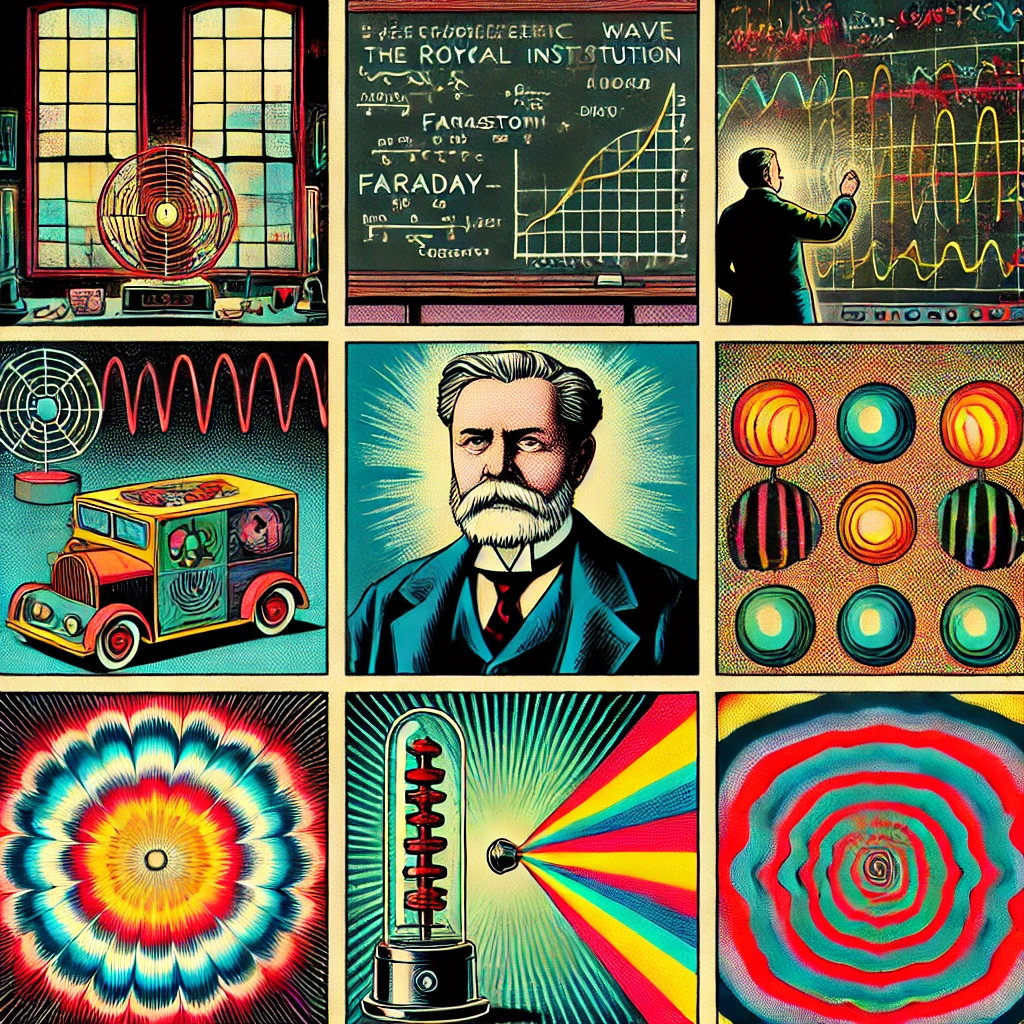Electromagnetic Waves Sir Lawrence Bragg Royal Institute
That the glass lense, like your cornea, focuses electromagnetic radiation is strong evidence supporting the theory that our evergrowing environmental toxin of radiofrequency radiation is primarily responsible for our evermore damaged eyesight, collectively.
Experiments and demonstrations on the nature of electromagnetic waves.
The nature of electromagnetic waves is demonstrated first with the aid of models and then by a reconstruction of Faraday’s experiment on induction. The range of electromagnetic waves is next illustrated, followed by a series of experiments using a klystron. The measurement of wavelengths is introduced by showing standing waves with the Vinycomb model, Sir Lawrence then illustrating the same principles by applying electromagnetic waves to Young’s pinhole experiment. From the original programme notes: Sir Lawrence Bragg at the Royal Institution of Great Britain Since 1826 a series of lectures, planned for young people, has been given at the Royal Institution during the fortnight after Christmas. These lectures, ‘adapted to a juvenile auditory’ to use the nineteenth-century phase, were started as a new venture in science teaching.
It is the tradition to illustrate the CHRISTMAS LECTURES with numerous experiments which are on an impressive scale and as far as possible of a novel type. Many experiments first shown in the Royal Institution theatre have become classical bench-experiments in schools and colleges, and many of the best popular scientific books have been based on CHRISTMAS LECTURES.
A scheme was launched in 1955 to give corresponding lectures throughout the school year, because it seemed very desirable to use the facilities and traditions of the Institution to the full and thus make it possible for a larger audience to participate. The idea was proposed in the first place to a few science teachers in schools, and with their help it was started in a small way. The lectures had an enthusiastic reception, and the scheme soon grew to its present proportions – over twenty thousand young people now come to the lectures each year. The main idea behind them is to show experiments, illustrating the basic principles of science, which are on too large a scale or involve too complicated apparatus to be readily staged with school resources. The majority of the lectures are on physical subjects, but chemistry and biology are also represented.
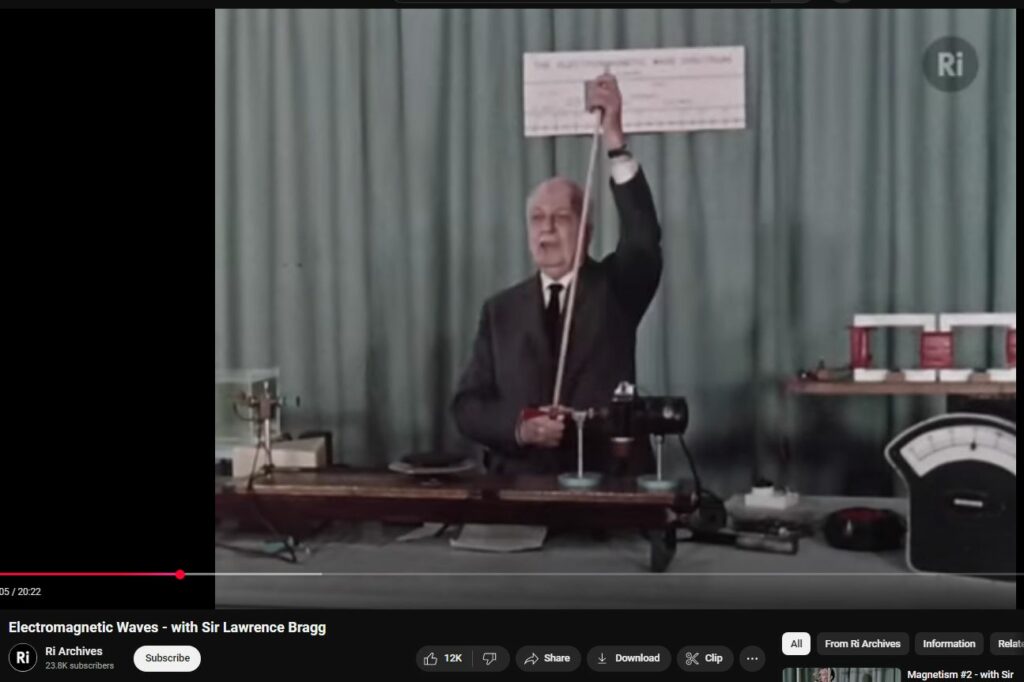
In 1965, Lord Bowden, who was then Minister of State in the Department of Education and Science, expressed a wish that the lectures given by Sir Laurence Bragg be recorded in the form of films, and arranged that a sum of money be earmarked for that purpose. The series Sir Lawrence Bragg at the Royal Institution is the result of his interest. The films have been commissioned by the Educational Foundation for Visual Aids and shot on the premises of the Royal Institution.
At first an attempt was made to film the actual schools’ lectures, but there were a number of drawbacks to this procedure. Ideal positions for the cameras were not possible in a crowded lecture room. An hour’s talk is too long, the film had to be divided into three or four sections, and it was not easy to tailor beginning and ends to the sections. It was finally realised that it would be much better to shoot each film as a separate project, with no audience and complete freedom for the camera team to take the long shots and close-ups in the best way. The possibility of close-up shots is a great advantage, because it enables effects to be shown which it would be impossible to demonstrate in a large lecture room.
The present series consists of sixteen films covering the schools’ lectures dealing with magnetism, the properties of matter, and vibrations and waves. It is hoped to include electricity and other subjects in a further series. In the main, the experiments are those actually shown in the schools’ lectures, modified for filming where desirable. The action before the camera is in each case carefully rehearsed so that the performance of the experiment is seen as clearly as possible. No attempt however has been made to prepare a ‘script’. The talk is quite informal, not a prepared one, in the belief that it will be fresher and more interesting if given in this way. It is hoped that the imperfections, inevitable in an impromptu talk, will be overlooked for the sake of its more personal nature.
I did not expect the glass lens to affect the EM waves like that! That really makes a connection for me that was always missing. The idea that radio, light, and X-rays are the same “stuff” but at different frequencies is now clear in a way it never had been before. My mind is blown.
This also proves what Ken Wheeler has been vehementing for quite a long time — that lenses having many elements (such as zoom lenses) ‘look worse’ than images captured thru prime lenses (ie, lenses having fewer glass elements) because the many glass elements negatively affect the blue end light of the light spectrum, causing a kind of ‘chromic smearing’ or delay, probably (this is my speculation) in the same way that negative feedback is ruinous to realism in sound quality.
Ein was controlled by Jesu of Vati in Rome as a means to limit scientific advancement. Royal Society has always used ‘peer review’ to squash fresh thought and knowledge. Heaviside, who translated Maxwell’s Equations, left out a few of them. This accounts for the lopsided misunderstanding of present day. KEN WHEELER and ERIC DOLLARD have much insight on this.
Blue light is about half as long as red light.
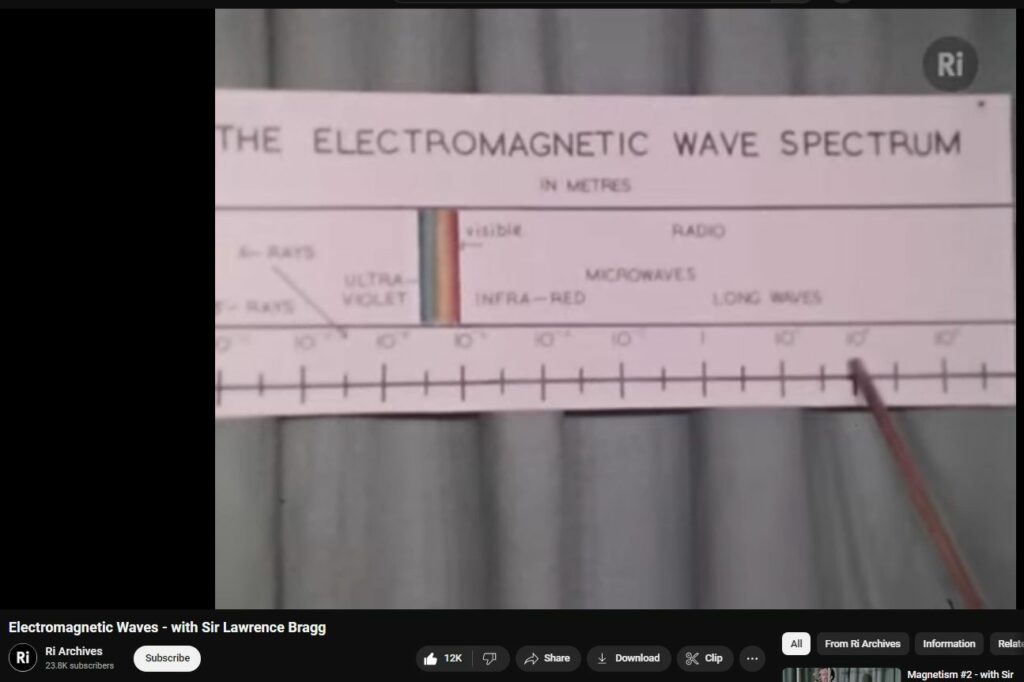
Refraction (wax wedge)
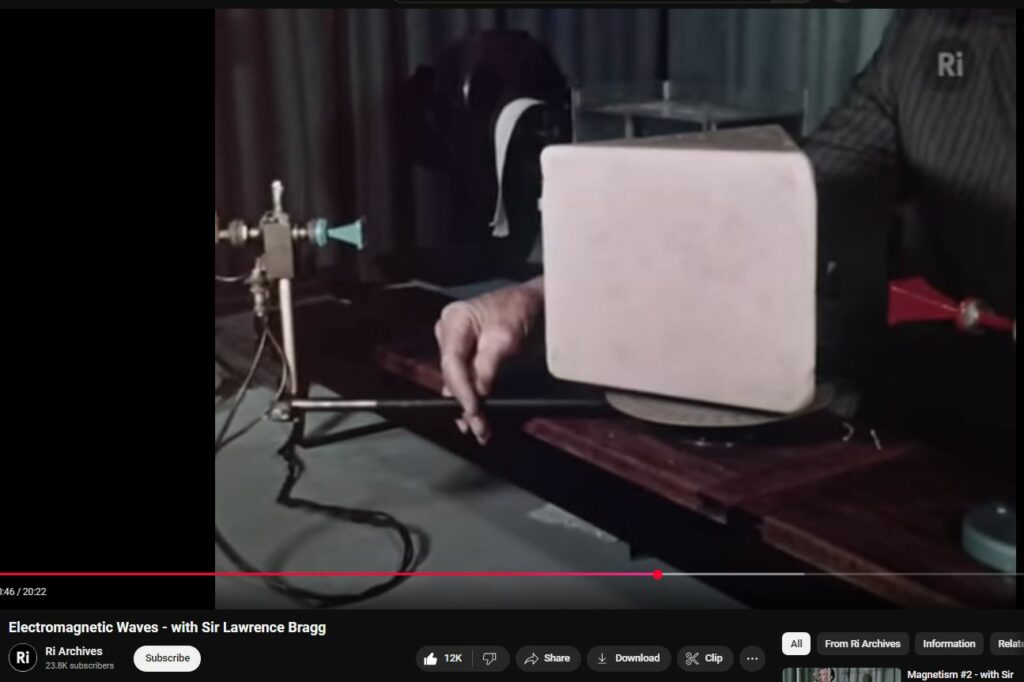
Reflection (aluminum block)
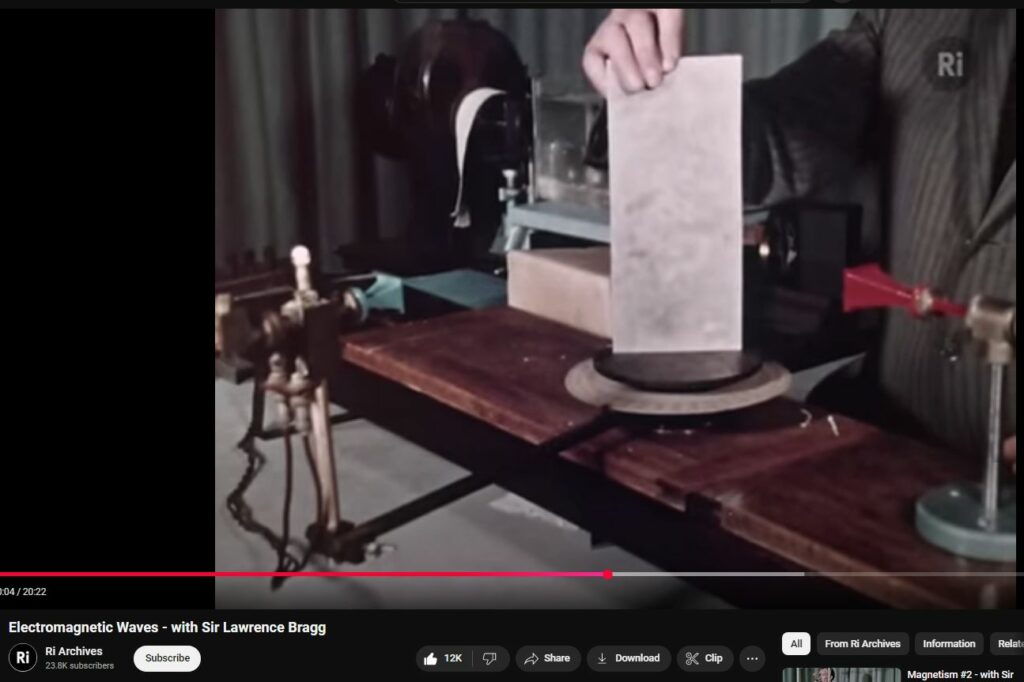
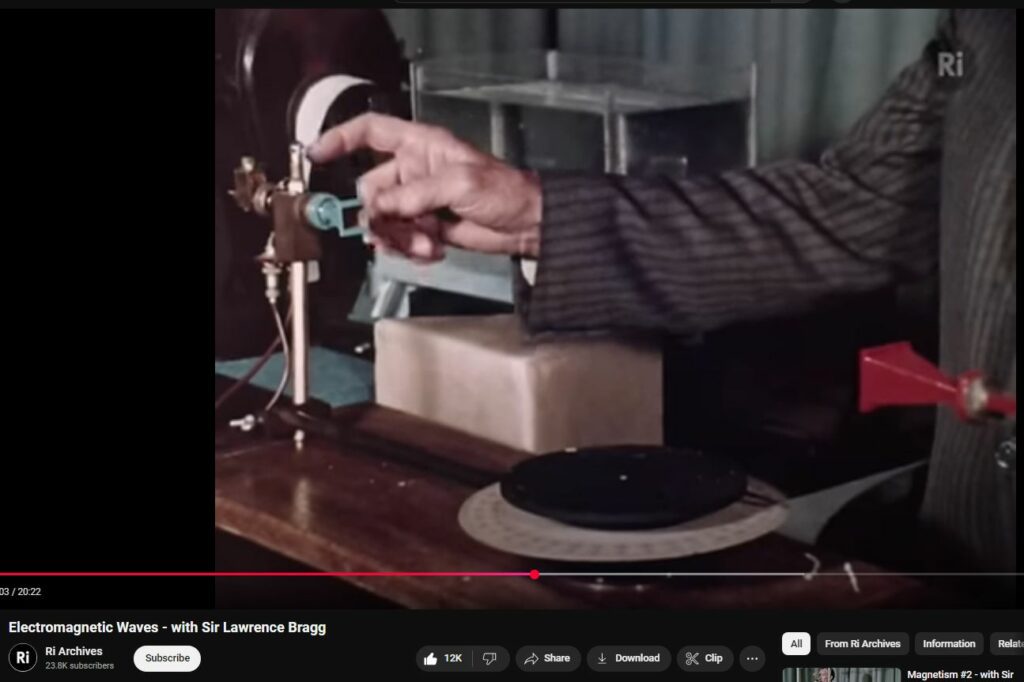
Polarization
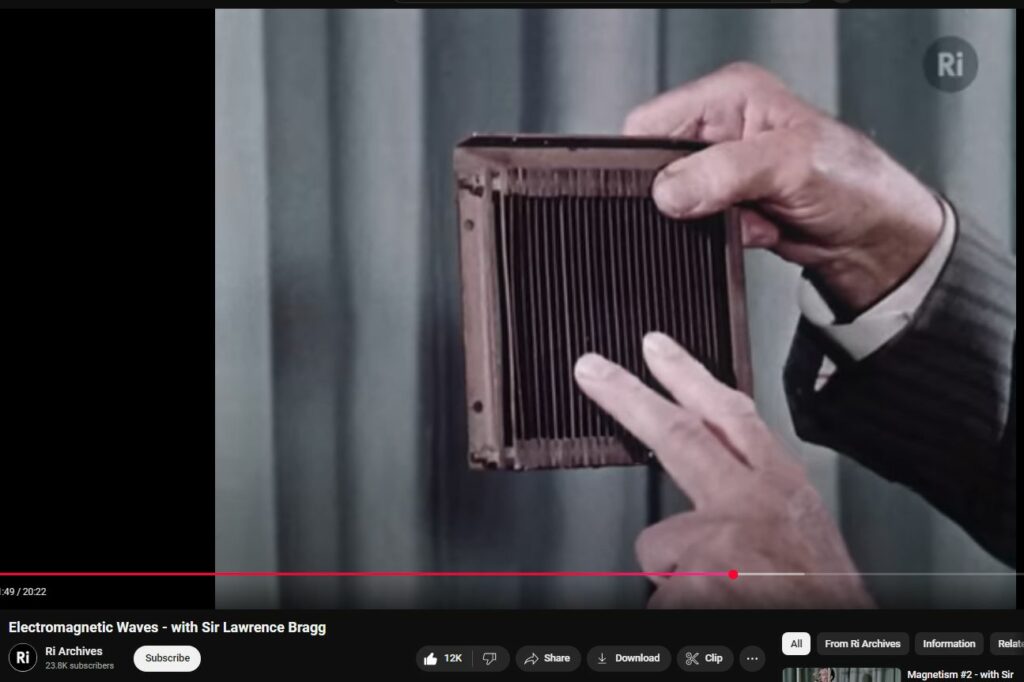
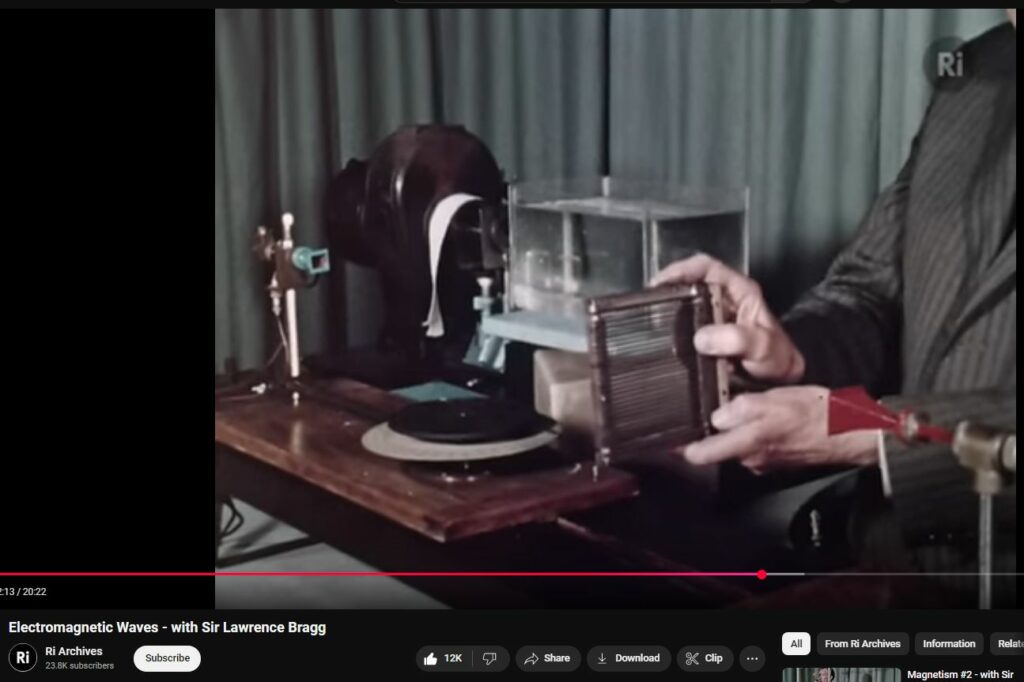
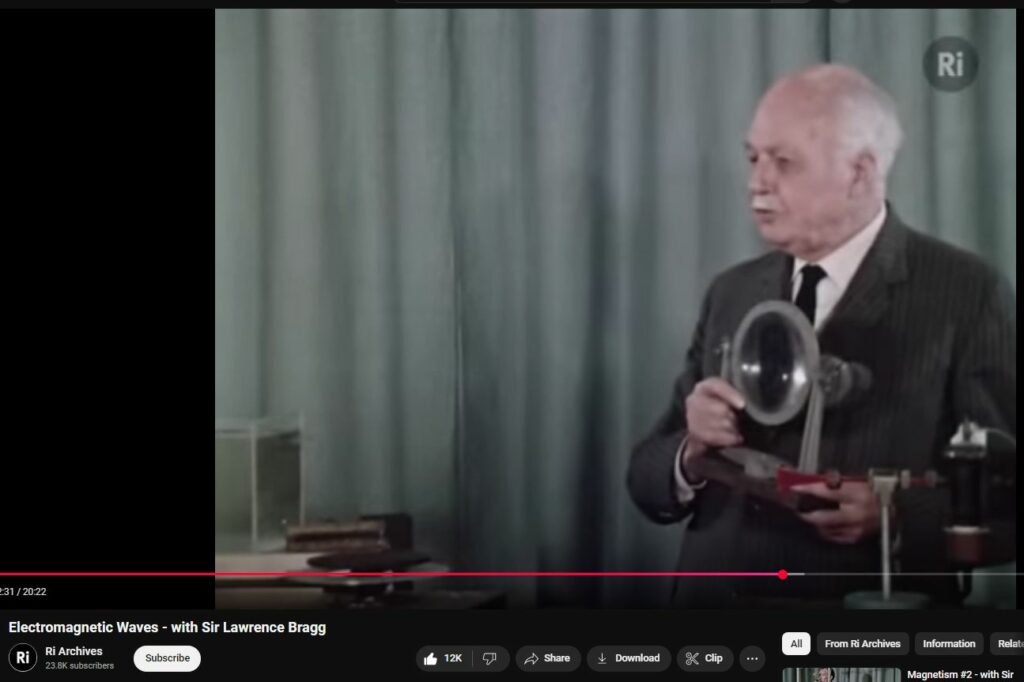
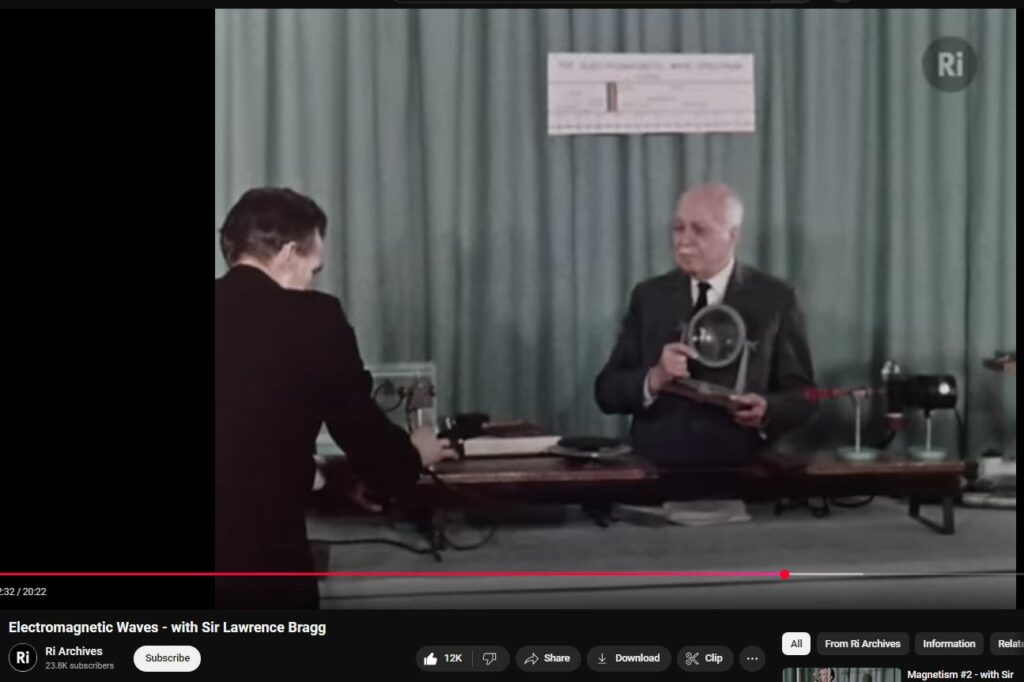
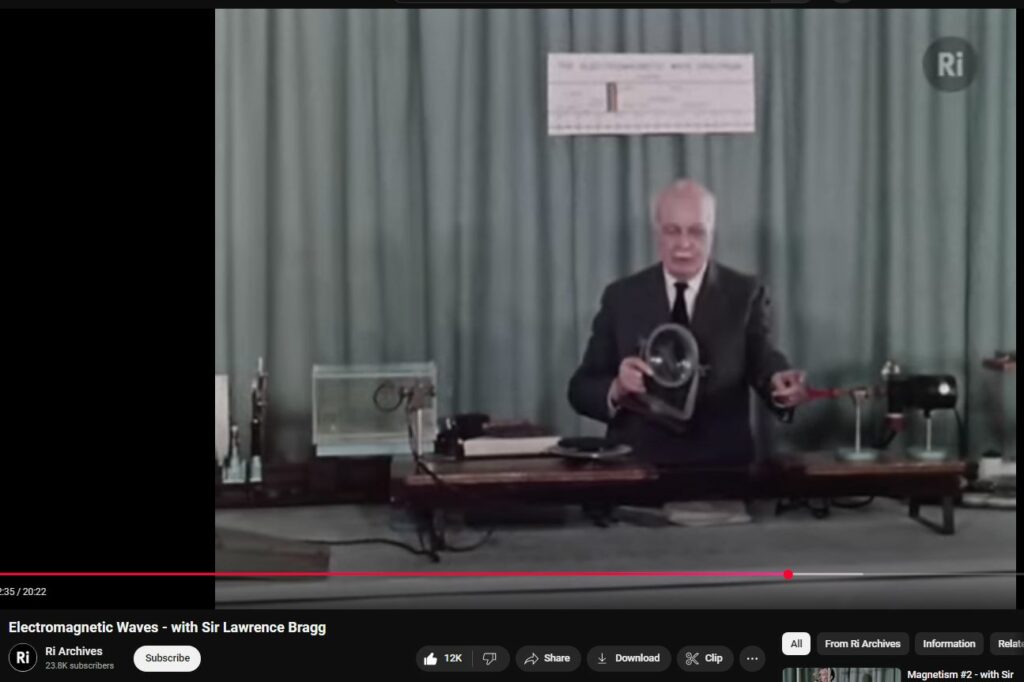
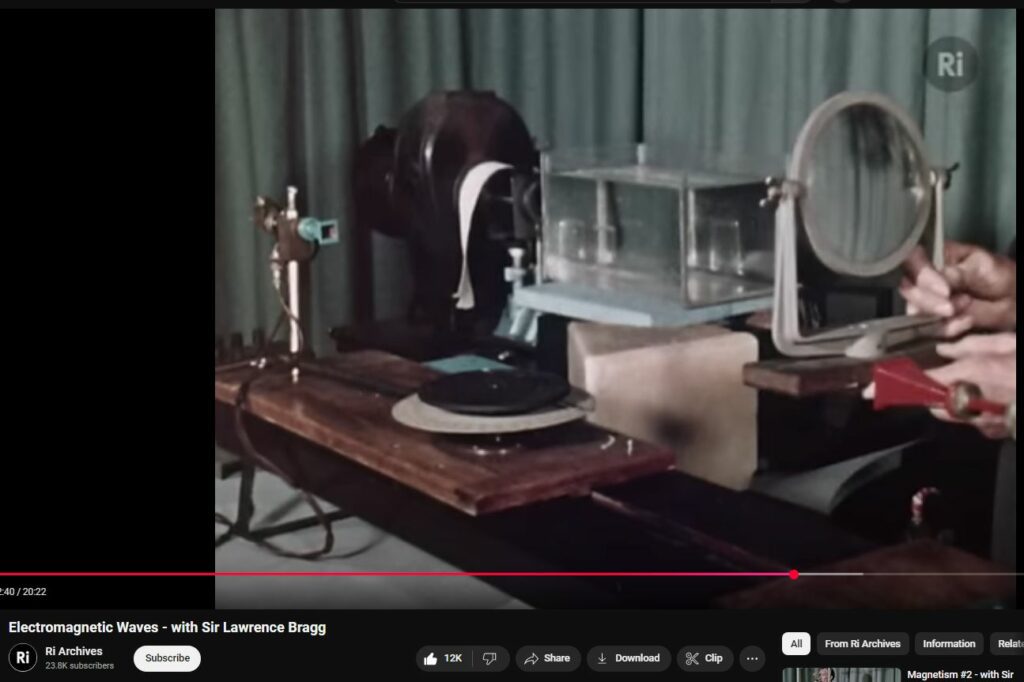
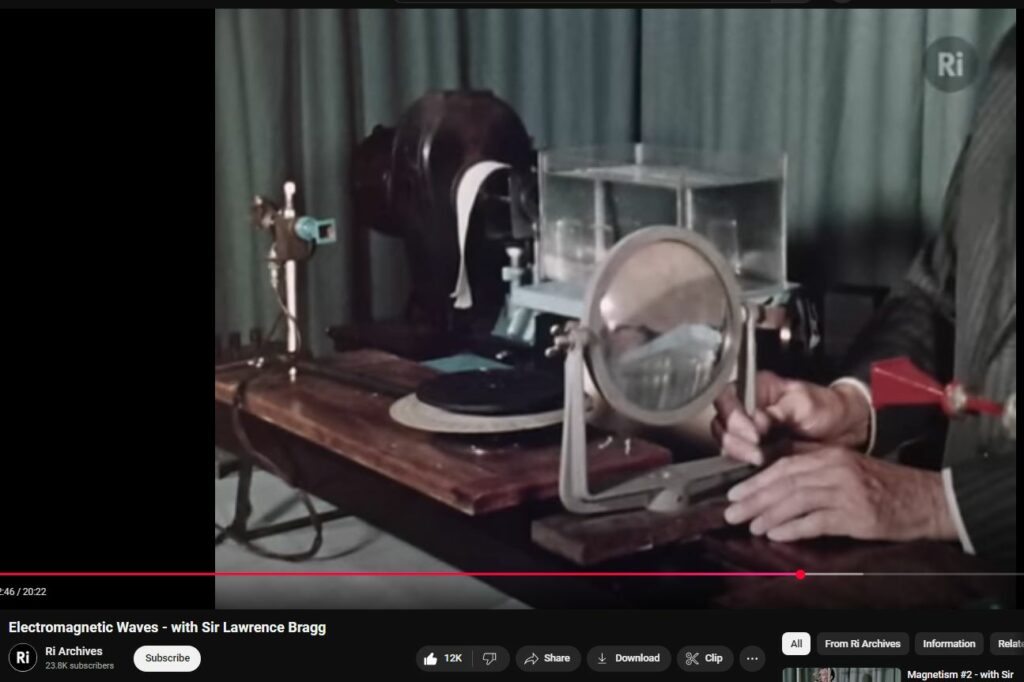
Concave mirror concentrates beam (collimation)
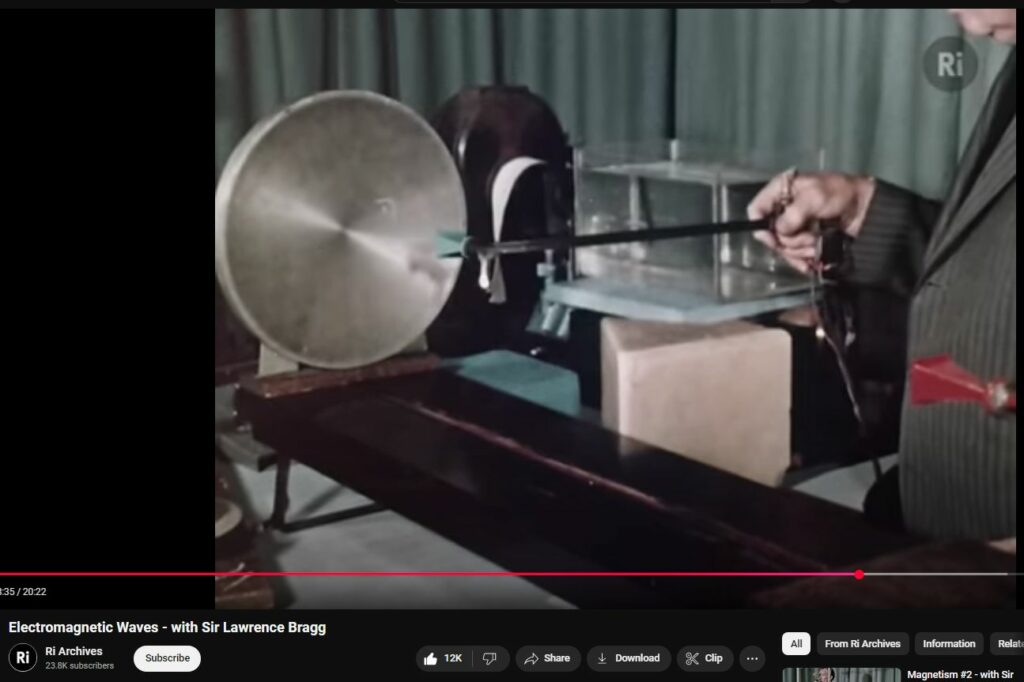
Exploring Electromagnetic Waves: Sir Lawrence Bragg’s Royal Institution Lecture
Sir Lawrence Bragg, a pioneer in crystallography and Nobel laureate, brought the wonders of electromagnetic waves to life in his legendary lectures at the Royal Institution. His ability to combine scientific rigor with engaging demonstrations made complex physics accessible to audiences of all backgrounds. One such lecture, focused on electromagnetic waves, remains a testament to his skill in education and experimental physics.
Understanding Electromagnetic Waves
Electromagnetic waves are fundamental to many aspects of modern technology and natural phenomena. From radio signals to visible light and beyond, they traverse space, carrying energy and information. Bragg’s lecture meticulously unpacked these waves through a series of illuminating experiments that demonstrated their properties and behavior.
Key Demonstrations from Bragg’s Lecture
1. Faraday’s Experiment on Electromagnetic Induction
Bragg revisited Michael Faraday’s groundbreaking experiment to show how a changing magnetic field induces an electric current. Using a coil, magnet, and galvanometer, he illustrated the principles that underpin electric generators and transformers—an essential foundation for electrical engineering.
2. The Spectrum of Electromagnetic Waves
Bragg outlined the vast range of electromagnetic waves, from radio waves to gamma rays. Using diagrams and practical demonstrations, he explained how different frequencies interact with matter and their various applications in communication, medicine, and science.
3. Klystron Tube and Microwave Demonstrations
One of the lecture’s highlights was Bragg’s use of a klystron tube, a device that amplifies high-frequency radio waves. This experiment vividly displayed the properties of microwaves, including reflection, refraction, and interference, reinforcing their relevance in radar technology and telecommunications.
4. Young’s Pinhole Experiment and Wave Interference
Bragg connected his discussion of electromagnetic waves to Thomas Young’s classic pinhole experiment, which provided strong evidence of light’s wave nature. He demonstrated how light waves interfere to form patterns, emphasizing the wave-particle duality in physics.
Impact of Bragg’s Lecture Series
Bragg’s lecture series at the Royal Institution was part of a broader effort to make physics more engaging and visually compelling. These demonstrations were designed not only to educate but also to inspire curiosity and deeper understanding in students and professionals alike. His approach set a high standard for scientific communication, ensuring that even the most complex ideas could be grasped through careful explanation and dynamic experiments.
Conclusion
Sir Lawrence Bragg’s lecture on electromagnetic waves stands as an exemplary fusion of scientific insight and educational mastery. Through hands-on experiments and clear explanations, he demystified electromagnetic principles that continue to shape our technological world. His legacy endures in the ongoing pursuit of knowledge, inspiring new generations of scientists and educators to explore the hidden forces that govern our universe.
Slits cause wave interference
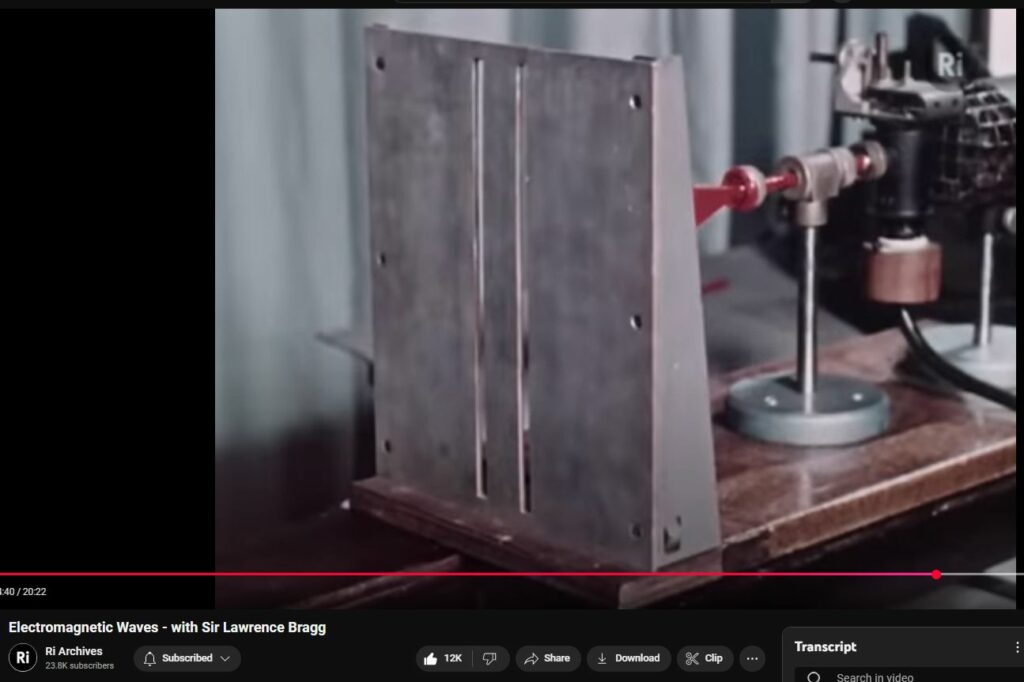
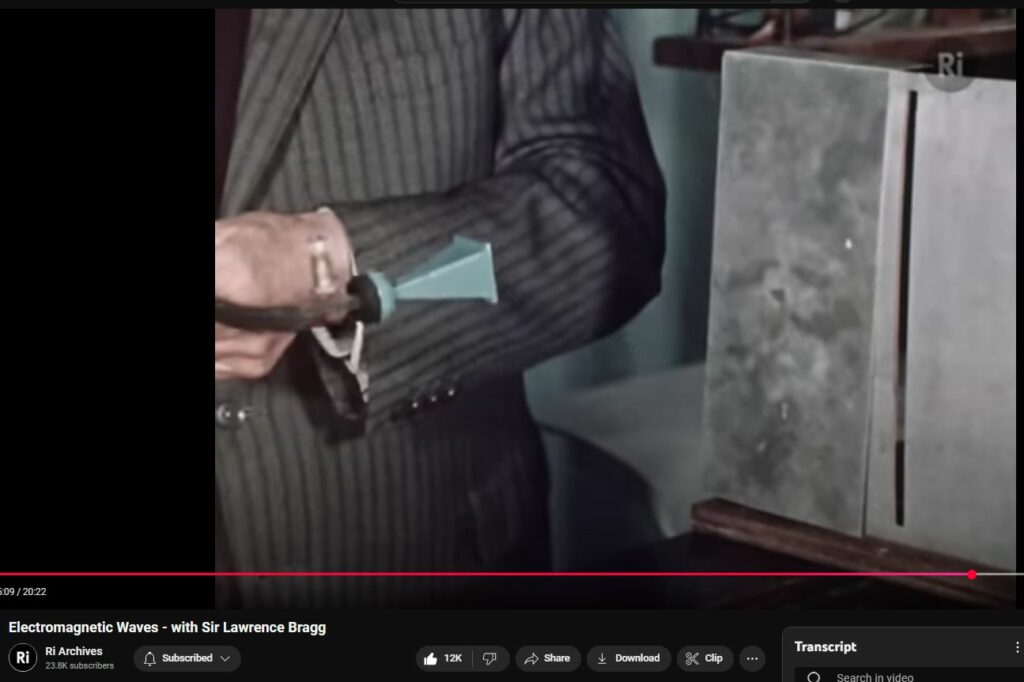
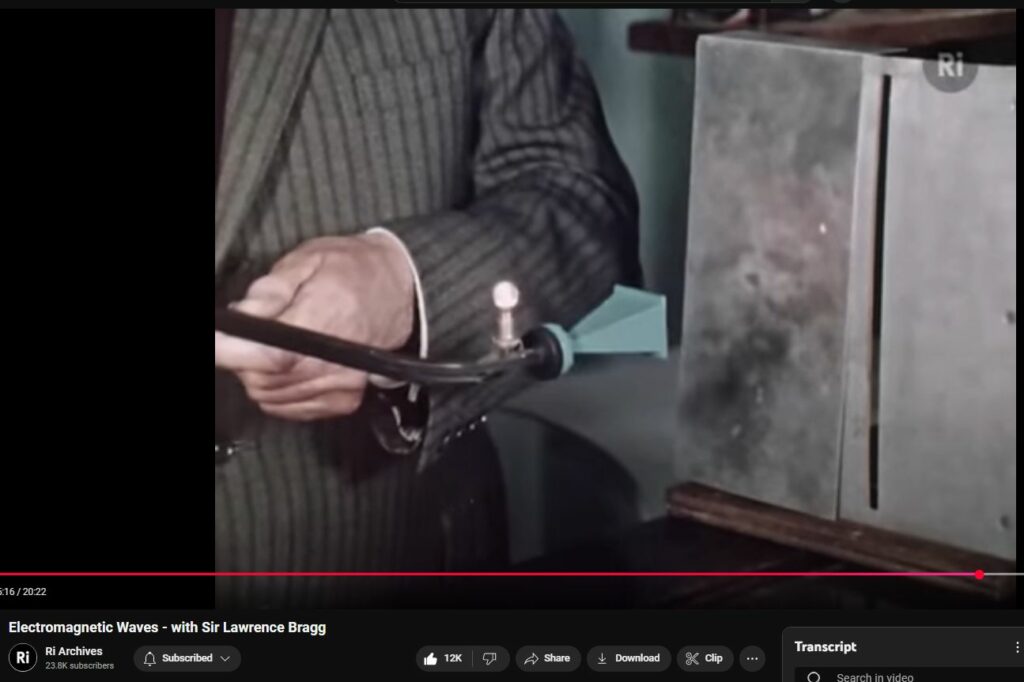
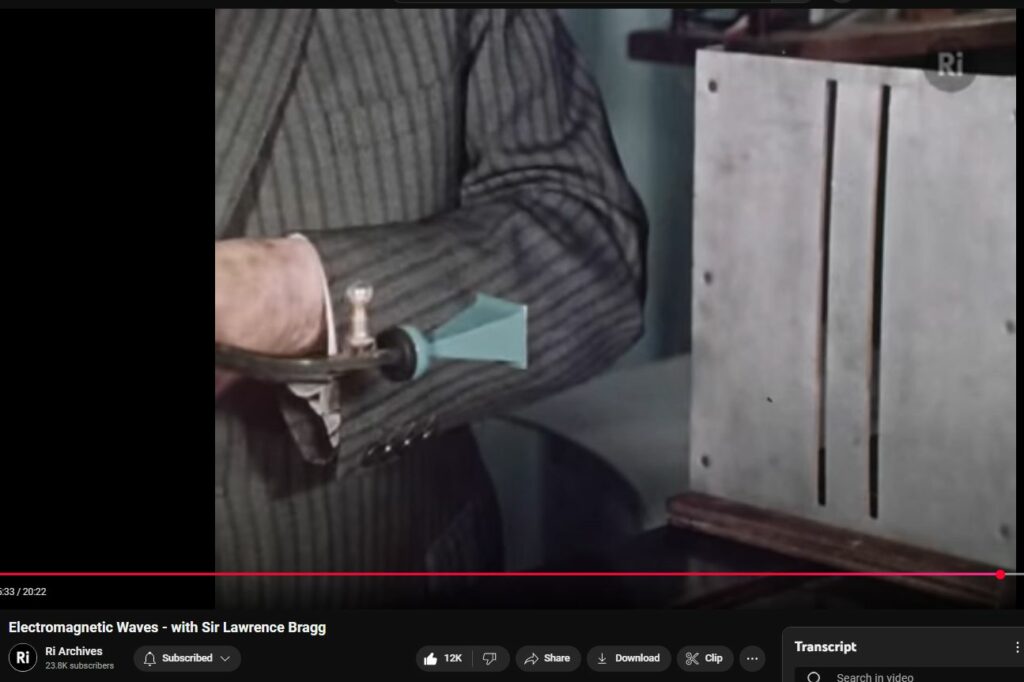
Standing waves cause nodes
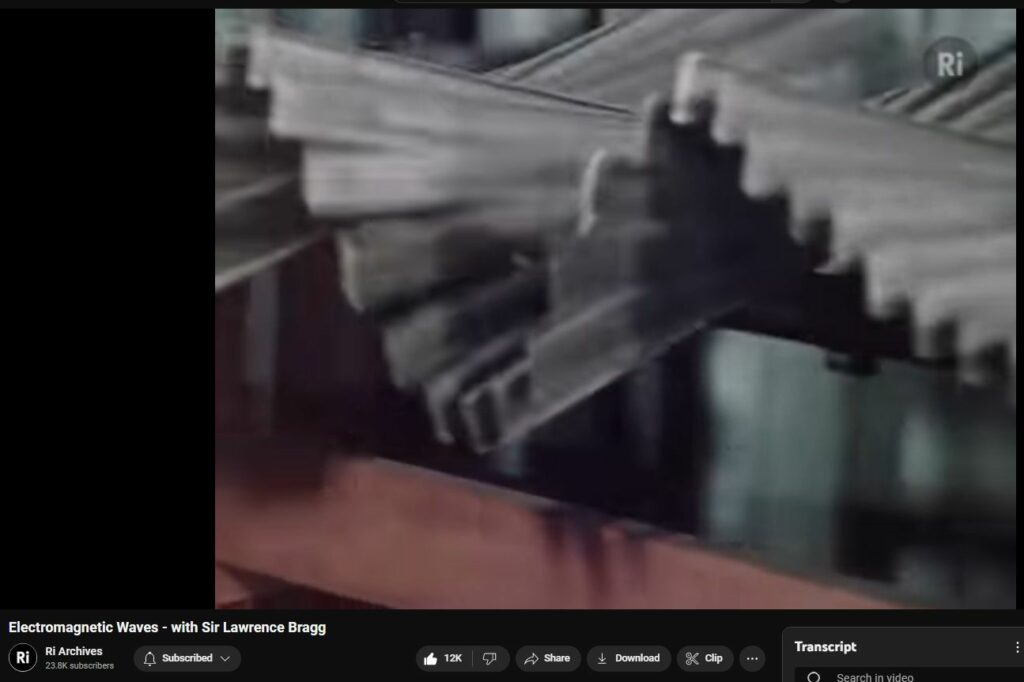
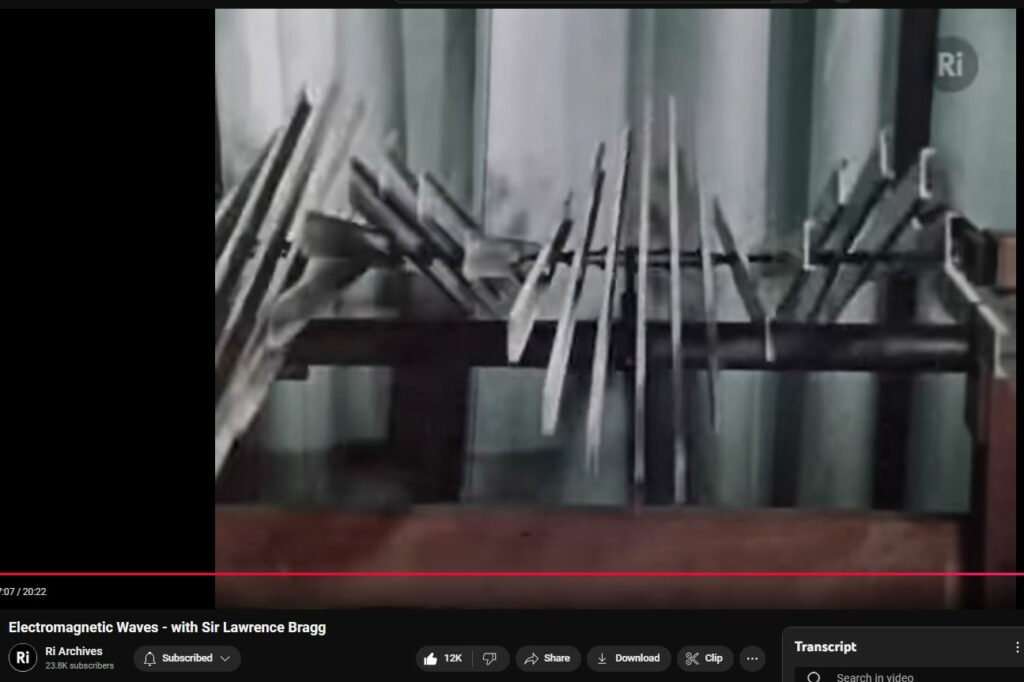
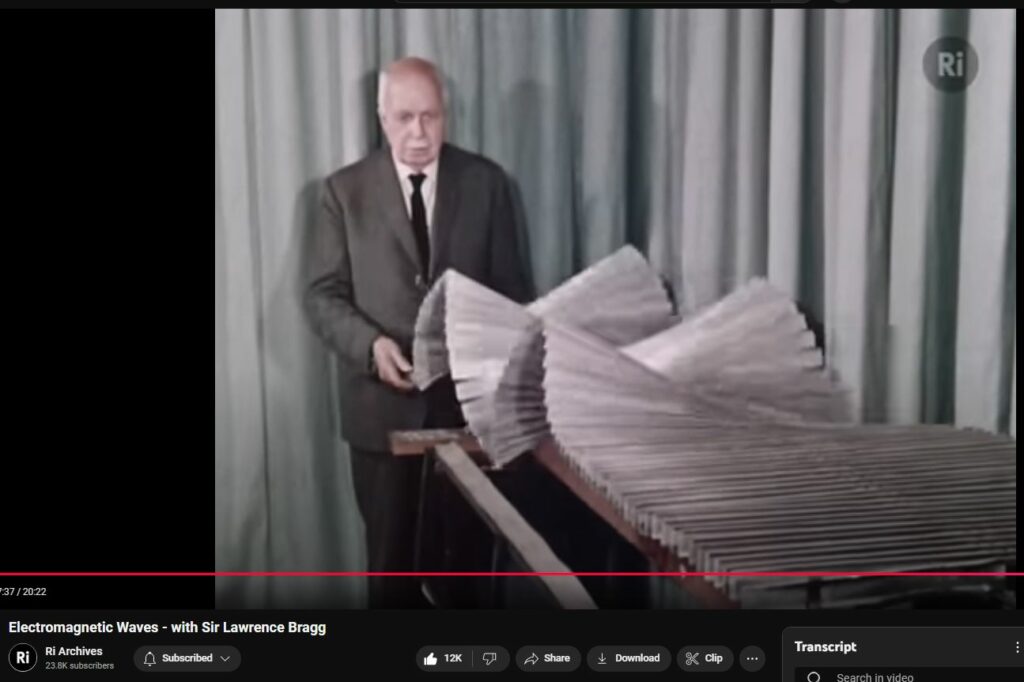
Wavelength
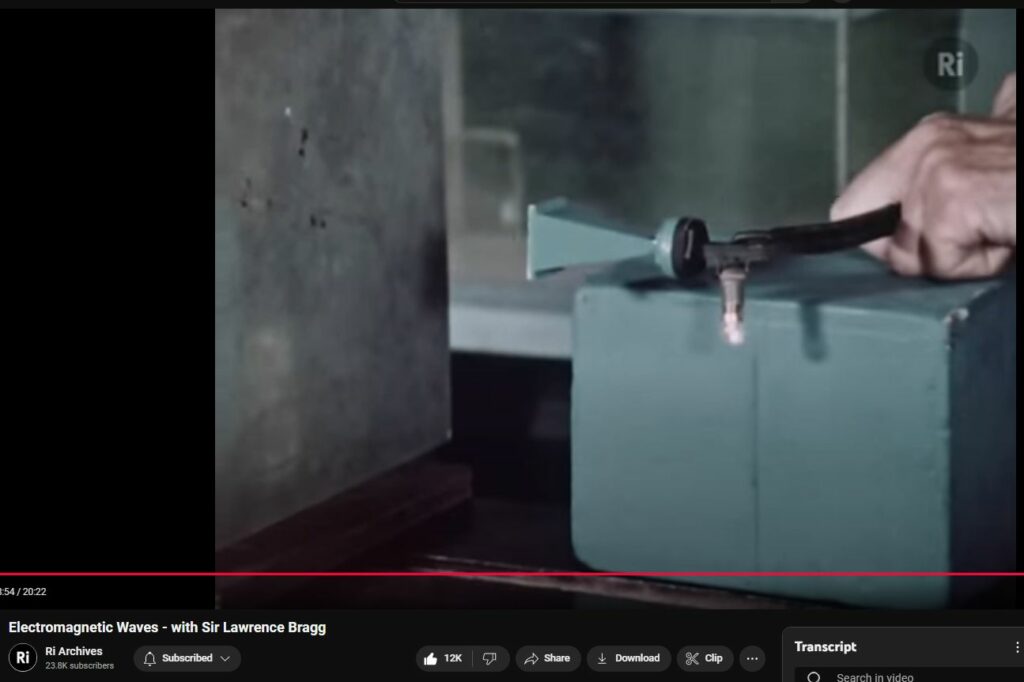
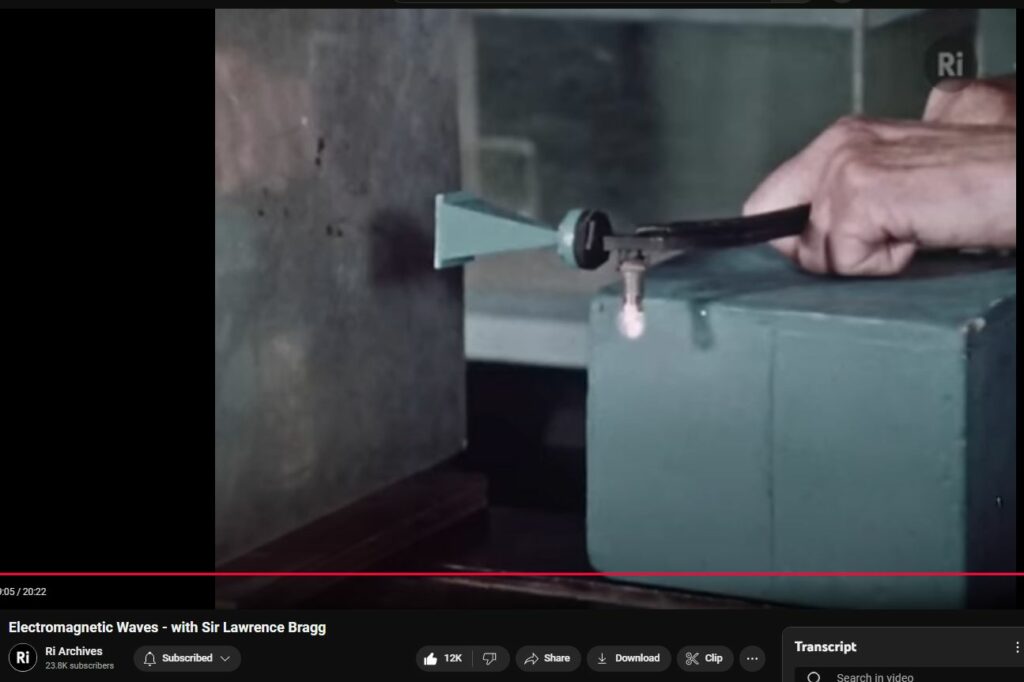
Transcript
0:33
this talk is to be about electromagnetic
0:36
waves these waves are tremendously
0:40
important I try and say something about
0:42
their nature in other types of wave
0:45
we're concerned with the movement of
0:47
matter uh waves in water sound waves
0:51
where the air moves or waves along a
0:52
rope or along a spring there's always
0:55
matter which is
0:56
moving electromagnetic waves are quite
0:59
indep dependent of
1:01
matter they are the kind of waves that
1:03
can exist without any matter being there
1:06
for instance the heat and light from the
1:09
sun is electromagnetic waves although
1:11
it's they're coming across empty space
1:15
to a physicist these electromagnetic
1:16
waves are almost one half of
1:21
physics now Faraday intuitively
1:24
recognize that there must be such things
1:27
that if you had a magnetic disturbance
1:29
or a electrical disturbance it ought to
1:31
be sent out as a disturbance into space
1:33
as a wave INF fact but he was not
1:36
mathematical he couldn't put it into
1:38
equations it was the great mathematician
1:42
Maxwell who first framed the right
1:44
equations and showed that if there were
1:46
such things as electromagnetic waves
1:48
they would go at the speed of light in
1:50
fact proved that light whose speed was
1:54
then known consisted of electromagnetic
1:57
waves what is their nature may I start
2:00
trying to explain it by reminding you of
2:03
two very simple effects the first one is
2:06
shown by Faraday's experiment on
2:10
induction here I've got a coil of wire
2:12
here I've got a magnet now the effect
2:16
that we're showing is this that if the
2:19
lines of force connected with a magnet
2:21
are moving past a point they will set up
2:24
an electrical field in this case the
2:27
electrical field will try to drive a car
2:30
around that wire so if I move the magnet
2:33
into the coil or out of the coil this
2:36
Emer here connected with the wire will
2:39
deflect if you watch the needle now
2:41
in
2:44
out in out parad experiment now just
2:49
notice the nature of this effect if the
2:51
lines of force of the magnet cut the
2:55
wires this way the force is that way
2:57
always a right angle the for electric
2:59
field is at right angles to the changing
3:02
magnetic field the opposite experiment
3:05
is this now we'll move the electrical
3:07
charges the electrical lines of force by
3:10
making electrons run around this wire in
3:13
other words by turning on a current that
3:16
again produces a magnetic field at right
3:18
angles the lines of force cutting this
3:21
way make a field that way when Mr coat
3:23
switches the current on we are
3:25
effectively making electrons run around
3:28
these coils this way way uh the lines of
3:32
force are cutting the AR this way
3:36
therefore magnetic field at right angles
3:38
of course is produced down this way we
3:40
magnetize the iron and so when the
3:43
current is turned on becomes quite a
3:45
strong
3:51
magnet and picks up all these
3:56
nails now that is the essential nature
4:00
of these electromagnetic waves let us
4:03
suppose that this is the aial of a radio
4:07
transmitting
4:08
station the transmitter is making
4:12
electrons Rush up and down this aerial
4:16
so you've got the lines of force attach
4:18
these electrons rushing up and down this
4:21
way that sets a magnetic field this way
4:23
just as in this experiment that magnetic
4:26
field makes an electrical field that
4:28
makes a magnetic field and so on out
4:30
goes a disturbance into space the radio
4:34
station is sending out its message as
4:37
electromagnetic
4:39
waves here's another way of putting it
4:41
with the help of this little
4:44
model what if I got
4:47
here a coil in which I can put an
4:50
alternating electrical current from the
4:53
veins that turns that into a magnet
4:56
backwards and forwards 50 times a second
5:00
the changing magnetic field inside this
5:03
coil makes a current running this coil
5:05
backwards and forwards 50 times a second
5:07
there's no connection you see this is
5:09
quite loose it's merely threaded by the
5:11
magnetic field that magnetizes that that
5:14
turns makes currents run here magnetizes
5:17
that backwards and forwards currents run
5:19
there and so the message is passed on
5:22
and if I turn on the switch at this end
5:26
you will see the current in this wire by
5:29
this little lamp lighting up and you
5:30
will see the message is passed onto the
5:33
other end and that lamp will light up
5:35
too
5:40
there although there's absolutely no
5:43
connection between the an and these
5:45
coils well now I've put in coils and
5:49
iron because I want the energy here all
5:51
to be collected to this end and light
5:53
this length but we could take away the
5:55
coil we could take away the iron you can
5:57
have an electrical field without
5:59
changing without electrons having to run
6:01
in a coil of water you could have a
6:03
magnetic field without there actually
6:05
being any iron there take away that
6:07
takeway that it's same time true if you
6:10
have a changing electrical field here
6:12
out it goes and you'll be picked up
6:15
there only much more feebly of course CU
6:17
it's rushing out in all directions in
6:20
space so that then is the essential
6:23
nature of an electromagnetic
6:28
wave how you got a diagram here uh which
6:31
shows the whole range of electromagnetic
6:33
waves in which we're interested here it
6:37
is and it's plotted in this way one here
6:40
on the diagram means one meter waves one
6:43
meter long and every one of these
6:45
intervals we go up 100 times that's
6:48
waves 100 m long 10,000 M long a million
6:52
M long going the other way is just the
6:55
opposite we go down that's 100th of a
6:58
meter 11,000 of a meter right down here
7:02
to 1 million millionth of a meter it's a
7:06
tremendous
7:07
range going from 10 6 to 10- 12 a
7:11
million million million times in this
7:15
range round about here
7:17
10,000,000 100 uh meters long uh we've
7:22
got long waves for radio in this region
7:25
here uh these are shorter waves and
7:30
down here where you get down to about a
7:33
centimeter we have the very high
7:35
frequency range of radio
7:38
waves coming further over we get what we
7:41
call infrared Rays heat waves the waves
7:45
whose warmth we feel when we stand in
7:47
the Sun and when we get down to about 1
7:50
millionth of a meter we begin to
7:54
see red waves have a wavelength slightly
7:58
less than 1 millionth of a meter and the
8:02
visible spectrum from the red to the
8:05
blue which I've drawn here in color
8:08
extends over about one
8:11
octave blue light is about half as long
8:14
as red light beyond that there's also
8:17
light but we can't see it what's called
8:20
the
8:21
ultraviolet and beyond that again we get
8:23
still shorter waves soft and then hard
8:26
xrays and then what's called gamma rays
8:29
radioactive substances and beyond that
8:33
again still shorter ones that come in
8:36
the cosmic rays so there then is the
8:39
range of electromagnetic waves that
8:41
we're going to
8:43
consider I've got here a valve it's
8:46
called a KRON which is sending out
8:49
electromagnetic waves just under 1 cm in
8:53
wave length out of this little horn here
8:56
at the other end here there is a
8:58
receiver which pi picks up these waves
9:00
and the pickup is shown both by this
9:03
little lamp here lighting up and by a
9:07
note I might say that the note you hear
9:10
is certainly not the frequency of these
9:11
waves which is of course very high
9:13
indeed these are modulated as the
9:15
electronics engineer calls it uh to to
9:18
give an audible sound so when this
9:20
receiver is picking up the the waves you
9:22
hear you hear a note and you see that
9:26
little bulb light up uh if Mr coat
9:29
switches on you will see this horn
9:31
receiving the Waves by this little lamp
9:33
lighting up and by the noise uh you can
9:36
see the waves are coming from
9:40
there I can cut them off with my hand
9:43
now reflection if I move this arm round
9:46
over here I now moved it of course out
9:49
of the out of the beam and so it's
9:52
picking up nothing but if I take a
9:54
mirror like this I can throw the signal
9:56
back into it by means of this reflecting
9:58
screen here piece of
10:03
aluminium There It Is Us there's
10:05
reflection F it's very
10:10
sharp reflection reflection here's a
10:14
prism made of paraffin works is
10:17
transparent to these waves although of
10:20
course it isn't transparent to light the
10:22
waves go slower in this prism than they
10:24
do in the air and therefore if I set
10:28
that now on my
10:30
table
10:33
here and move this round I hope we'll
10:37
pick up the refracted waves through that
10:41
block there they
10:51
are now we can turn this a
10:57
little you see it's sensitive both the
10:59
position of the prism and the position
11:02
of the
11:04
arm polarization now this is an
11:07
interesting
11:08
effect we've seen that these
11:10
electromagnetic waves the magnetic and
11:14
the electric fields are at right angles
11:17
to the way in which the waves are
11:20
traveling uh in this particular case
11:23
this KRON is sending out waves which the
11:27
electric field is up and down
11:30
I can show that by means of this screen
11:33
here I'll move this round first of all
11:35
so it picks up the direct
11:37
beam and here I've got a screen of
11:42
conductors now if I place that in such a
11:45
way that these conductors are parallel
11:49
to the electrical wave they kill it as
11:52
it were they being conductors a current
11:55
flows in them to kill the PO electric
11:57
polarization so you will see if I hold
12:00
this with the rods vertical it cuts it
12:05
out if I turn it round and hold them
12:10
horizontal it goes
12:13
through
12:15
vertical horizontal that's showing you
12:17
see that the electric Vector in this
12:19
case is in this direction at right
12:21
angles of propagation of the Waves
12:25
focusing with a lens here we've got a
12:28
perspect lens
12:30
coot is going to move that receiver back
12:32
so it barely hears the waves from this
12:36
KRON but if I put the lens here in the
12:40
path of the Rays it will focus the
12:42
electromagnetic waves onto that receiver
12:50
see take the lens away and we don't get
12:53
the single
12:55
again or focusing with a concave mirror
13:00
uh coat has here a concave mirror and
13:04
this time I'm going to pick up the
13:06
reflected me I'm going to look for the
13:07
focus by means of this similar receiver
13:11
there is a little horn which will pick
13:13
up the waves which I can move about now
13:16
the waves are coming out of this Cinder
13:18
they're being focused Somewhere Out Here
13:20
by that concave mirror and I think I
13:22
hope I'll be able to find the focus by
13:24
feeling for it with my receiver
13:30
there it is you
13:32
[Music]
13:40
see I'm passing through it at about that
13:43
point there so you will see that this
13:46
concave mirror focuses the
13:48
electromagnetic waves somewhere out here
13:51
just as in the case of light well now
13:55
I'm going to repeat with my
13:57
electromagnetic waves
13:59
the very famous experiment of Thomas
14:02
Young the pinhole experiment when he got
14:05
the interference fringes which proved
14:08
that light consisted of waves in the
14:11
case of Young's experiment he had to put
14:13
the pin holes very close together indeed
14:16
he had to look at the fringes which were
14:18
still quite close together at quite a
14:20
distance away because in that case the
14:24
wavelength of light is so very short
14:27
indeed with these centimeter waves we
14:30
can do everything on a much coarser
14:33
scale Mr coats will put two slits in
14:37
front of the beam of waves here they are
14:41
these two slits uh in this screen U and
14:46
I'm going now to pick up what I get on
14:49
the far side with this receiver which I
14:52
can move about first of all I will cover
14:55
up one of the
14:56
slits like that and now if I search
15:00
across the field with my receiver you'll
15:02
see that just is a patch a single patch
15:06
of waves coming through that
15:11
[Music]
15:17
slit so but now if I uncover this slit
15:22
now we got two sets of waves coming
15:24
through and we'll see the interference
15:26
fringes between those two sets as I move
15:29
this
15:37
[Music]
15:39
across as I pass through one two Cal one
15:43
out there so the interference is taking
15:46
place uh between these
15:48
waves well finally I want to show you an
15:51
experiment uh which measures as it were
15:56
the length of these waves may I first
15:59
remind you what we mean by standing
16:01
waves and I can demonstrate that again
16:03
by means of our Vino model which I've
16:06
got over
16:07
here here is my vinum model and I can
16:12
send waves along it by oscillating this
16:15
Rod at one end now what I want you to
16:17
notice is this that if I send a series
16:20
of waves along this model and the
16:24
reflected waves meet the oncoming waves
16:27
they produce a series of nodes and
16:30
Loops nodes where the rods remain
16:33
stationary and Loops where they're
16:35
oscillating backwards and forwards and
16:38
if you keep in mind the scale of the
16:40
Waves I'm sending along and look at
16:42
these nodes and Loops you'll see that a
16:45
wavelength includes two Loops it's the
16:48
distance between alternate nodes well
16:51
now I'll start by sending a series of
16:53
rather short waves along and you'll see
16:55
these nodes and loops
17:02
now they're going to be
17:07
reflected do you see how it's
17:10
beating in this series of nodes and
17:12
Loops well now we'll repeat it with
17:15
rather longer waves I'll ask Mr coats to
17:17
damp our
17:20
model I start with it still again now
17:23
I'll send rather longer waves along and
17:27
of course in this case the nodes and
17:29
Loops will be on rather a larger scale
17:32
watch
17:44
now well now I'm going to illustrate the
17:49
same principle uh with my
17:53
electromagnetic wave set up over
17:56
here here again is
17:59
my sender which is sending out these
18:02
electromagnetic waves if we take the
18:05
double slit
18:06
away and put at the end here a plain
18:10
reflecting
18:12
mirror now we've got the train of waves
18:15
coming along from the center here
18:17
reflected by that mirror and interfering
18:20
making beats uh between the two sets of
18:24
waves going that way and this way in
18:26
this case the waves are rather less than
18:29
a centimeter apart in fact this is an
18:30
experiment to measure the length of the
18:33
waves and as the waves are about a
18:35
centimeter long the Beats will be half
18:38
that apart actually about 4 and 1 half
18:40
millim so I've got to look for them
18:44
rather steadily and I put my hand on the
18:46
Block like this and move this very
18:48
steadily backwards and forwards I hope
18:50
you'll see it passing through the nodes
18:52
and loop so
18:59
you'll see they're about half a
19:00
centimeter
19:01
[Music]
19:17
apart you can hear it chattering as I go
19:19
quite fast so there you see we are
19:22
actually observing with this what we saw
19:25
with the vinum model and of course
19:29
these various phenomena that I've been
19:31
illustrating with these centimeter waves
19:34
are characteristic of the much shorter
19:37
light waves and of the x-rays which are
19:40
very much shorter still
